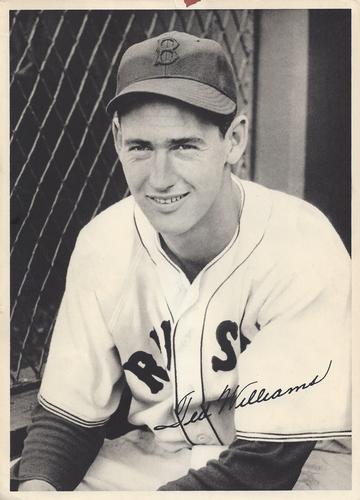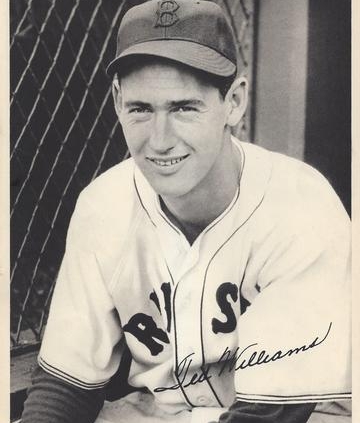June 24, 1942: Ted Williams hits first of 12 homers off Virgil Trucks, a game-winner for Red Sox
 Ted Williams hit 12 home runs in 123 career at-bats against Virgil Trucks, more homers than he hit off any other pitcher. Needless to say, you have to be a good pitcher to even get into that many games.1
Ted Williams hit 12 home runs in 123 career at-bats against Virgil Trucks, more homers than he hit off any other pitcher. Needless to say, you have to be a good pitcher to even get into that many games.1
Trucks won 177 games in his 17-season major-league career, but not his start at Detroit’s Briggs Stadium on June 24, 1942. It was a “twilight” game between Trucks’ Detroit Tigers and Williams’s Boston Red Sox, and there was only one run scored in the game — Williams driving himself in with his seventh-inning home run into the right-field stands.2
The visiting Red Sox were in second place. The New York Yankees led the pack, with Boston seven games behind and Del Baker’s Tigers in fourth place, 10½ games back but only one game behind the third-place Cleveland Indians.3
Right-hander Trucks, who had turned 25 earlier in the season, began the game with a 5-3 record. He’d pitched two innings in 1941, but 1942 was his first full year in the majors.
Charlie Wagner was the starting pitcher for the Red Sox. This was his fifth season in Boston. Early in June he had been 4-5 (despite a very good 2.80 ERA) but had won his last two decisions, a three-hitter against the White Sox at Fenway Park on June 7 and a 1-0 shutout of the White Sox in Chicago on June 19. The game in Chicago had been won by Dom DiMaggio’s inside-the-park home run.
The 6 P.M. twilight game—the first ever held at Briggs Stadium—had some fan appeal, drawing 13,193 on a late Wednesday afternoon, despite inclement weather that delayed the start of the game by more than 15 minutes. That was about double the size of weekday afternoon games in Detroit that year. The game itself was completed in 1 hour and 34 minutes—even with the Tigers batting in the bottom of the ninth.
After two outs in the top of the first inning, right fielder Lou Finney singled for Boston and left fielder Williams did the same. After two outs in the bottom of the first, center fielder Doc Cramer for Detroit singled, too. No runs were scored by either team in that inning, or any of the first six innings.
In the second inning, both teams benefited from a one-out fielding error by the opposition. Third baseman Jim Tabor reached on an error by right fielder Ned Harris. He was caught stealing. The Tigers’ third baseman, Pinky Higgins, reached, on an error by Tabor. Second baseman Jimmy Bloodworth grounded into a 4-6-3 double play.
Red Sox rookie shortstop Johnny Pesky singled in the third inning, but was (like Tabor) caught stealing, this time for the third out. The Tigers were three up and three down.
Williams doubled but was the only Red Sox batter to reach base in the fourth. Barney McCosky singled for Detroit but was the only Tiger to reach base, though after Cramer hit into a 1-6-3 double play, Dom DiMaggio braced himself against the center-field wall and grabbed what would have been a home run by first baseman Rudy York. “Just as the ball came down, he placed one hand on top of the little barrier. … Dom’s timing was perfect. He pulled down the ball with his gloved hand at full reach above his head. It was one corking bit of work.”4 The Detroit Times called it a “superman leaping one-handed catch.”5
In Boston’s fifth inning, Tabor reached on Trucks’ error but was thrown out stealing second. Wagner retired the Tigers in order.
Neither side had anyone reach base in the sixth inning; it was six-up, six-down.
Ted Williams was the first batter in the top of the seventh. He hit a 1-and-1 pitch and “met the ball so solidly that everybody in the park knew that it was ticketed for the circuit. It landed well up in the upper tier, out toward center.”6 It left the field of play “over the 370-foot mark into the lower deck of the right field stands.”7 Bobby Doerr flied out to left field, but Tony Lupien singled and reached second base soon afterward when Trucks threw errantly on a pickoff attempt. Tabor singled but Lupien had to hold at third base. Bill Conroy took a called third strike. Wagner grounded out to shortstop Billy Hitchcock, who threw to York at first base.
Wagner once more retired the side in order.
There was a walk, a passed ball, and another walk in the Red Sox eighth, but Williams (given that he already had a single, double, and home run, manager Joe Cronin had yelled “Make it the cycle, Kid!”)8 popped up to the middle infield and Doerr was called out on strikes. Detroit’s Higgins singled with one out but Bloodworth hit into a double play.
Bill Conroy was the only player for either team to reach base in the ninth inning, and he was picked off first. Charlie Gehringer pinch-hit for Trucks, but grounded out to the pitcher.
Charlie Wagner threw a three-hitter for the victory, facing only 28 Tigers (none of whom got past first base.) With the two double plays, two of the three who reached base were erased. Wagner walked no one at all. The Red Sox left seven runners on base; the Tigers left one.
For Wagner, it was back-to-back 1-0 shutouts, following the one in Chicago on June 19. He finished the season 14-11 (3.29).
Trucks finished the 1942 season with a 14-8 record and a 2.74 earned-run average. Even though he’d given up this home run, he gave up only two others all season long and led both leagues in fewest home runs per nine innings with a 0.161 rate.
The 12 homers Williams hit off Trucks spanned career home run number 108 (this one) to home run 444 on July 16, 1957, more than 15 years later and also a solo homer. The 12: 108, 115, 146, 174, 189, 226, 236, 243, 320, 342, 437, and 444. Five of the 12 were solo homers, five were two-run homers, and two were three-run homers. Four of them were game-winners, numbers 174 (May 19, 1947), 189 (August 2, 1947), and 243 (July 16, 1949) being the other three.9
Acknowledgments
This article was fact-checked by David Krell and copy-edited by Len Levin.
Sources
In addition to the sources cited in the Notes, the author consulted Baseball-Reference.com and Retrosheet.org.
https://www.baseball-reference.com/boxes/DET/DET194206240.shtml
https://www.retrosheet.org/boxesetc/1942/B06240DET1942.htm
Notes
1 The 123 at-bats against Trucks were the third-highest number of at-bats against a single pitcher in Williams’s career, behind Bob Feller (154) and Early Wynn (137).
2 This paragraph comes from Bill Nowlin, 521: The Story of Ted Williams’ Home Runs (Cambridge, Massachusetts: Rounder Books, 2013).
3 The Red Sox more or less held their spot, finishing the season in second, nine games behind the Yankees. The Tigers, however, dropped to fifth place and finished 30 games back.
4 Melville Webb, “Ted Williams’17th Homer Wins 1-0,” Boston Globe, June 25, 1942: 21. The account in the Boston Herald said DiMaggio grabbed onto the netting and pulled himself up as much as four or five feet to catch the ball.
5 Leo Macdonell, “3 Red Sox Combine to Beat Tigers, 1 to 0,” Detroit Times, June 25, 1942: 25.
6 Burt Whitman, “Sox Win on Williams Homer,” Boston Herald, June 25,1942: 12.
7 Macdonell. One suspects that Macdonell, more familiar with Briggs Field than the visiting Whitman, located the landing spot of the ball more accurately, and that the ball landed in the lower deck and not the upper tier.
8 Whitman.
9 A “game-winning home run” is defined here as a home run that provides a game’s final margin of victory, giving the winning team at least one more run than the opposing team scored. For example, if a two-run homer increased a team’s lead from 2-1 to 4-1, and they went on to win 4-3, it qualifies as a game-winning home run. (This is different from the definition of “game-winning RBI” in baseball’s official statistics from 1980 through 1988, which counted as “game-winning” the RBI that provided a winning team the lead that it never relinquished.)
Additional Stats
Boston Red Sox 1
Detroit Tigers 0
Briggs Stadium
Detroit, MI
Box Score + PBP:
Corrections? Additions?
If you can help us improve this game story, contact us.


